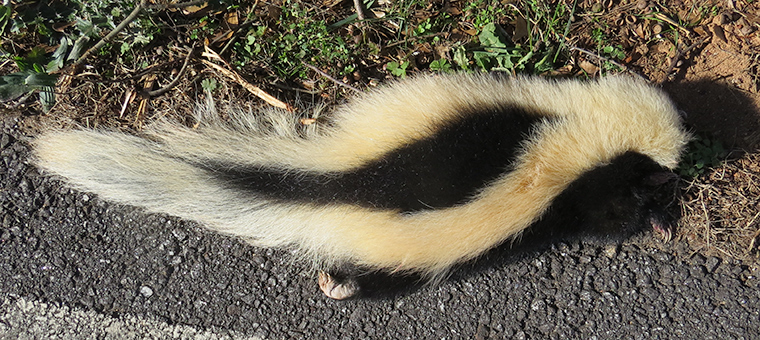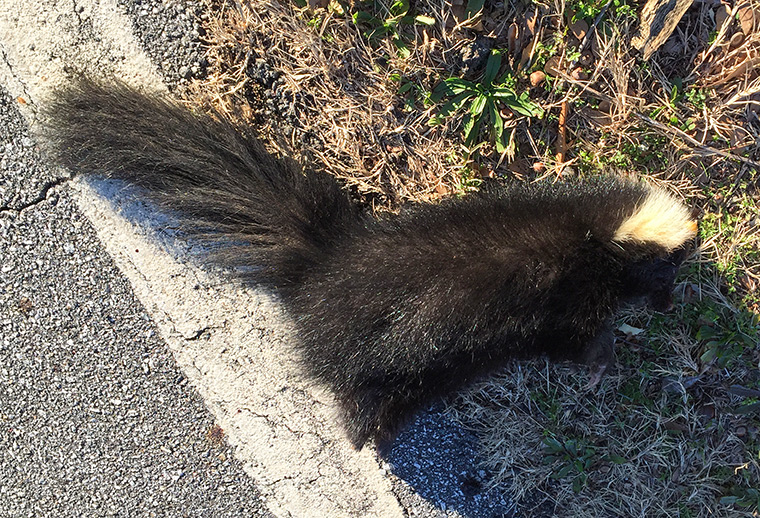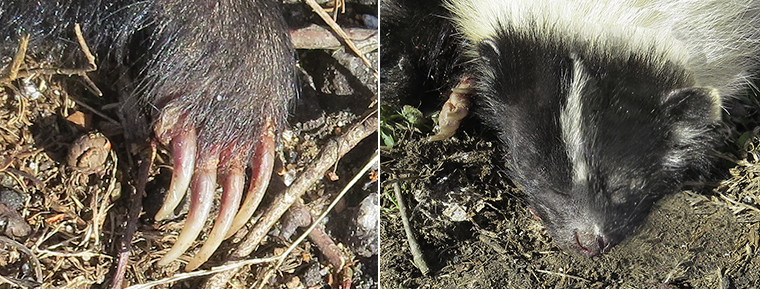I always like to stop to examine road kill. On this day I found 2 dead Striped Skunks (Mephitis mephitis) along the road. The animal in the first photograph was a full-grown male, about 24 inches long from its nose to the tip of its tail. It has a large amount of white fur relative to black. The second animal was about the same size, but it was entirely black, except for a white patch on the top of its head and neck. These two photographs illustrate how the amount of white fur can vary considerably between animals, with some being nearly entirely black.
Skunks used to be a very valuable source of pelts for the fur trade. The higher the percentage of black on the animal the more valuable would be its pelt. Skunk pelts were graded #1 to #4. The nearly all black animal in the second photograph would be a #1 pelt, while the first photograph shows a skunk that would grade as #4, the least valuable.
Large scale trapping of skunks for the fur trade started in the middle 1800s. The market for skunk furs was in Europe, however, not in the U.S. Skunk farming began about 1880 in the U.S., and prospered for a while. More than 2 million skunk pelts were traded in London in 1911. The First World War interfered with European fur trading, but American auction houses took over the business, and Americans began to warm up to using skunk furs. After the war was over, the “Golden Age of Skunk Fur” began. In 1920, for example, the average skunk pelt sold for $5.14. That is more than $60 in today’s money. The U.S. Department of Agriculture issued a Farmer’s Bulletin entitled “The Economic Value of North American Skunks” in 1914 and revised it in 1923. It makes very interesting reading if you are at all interested in the subject. Incidentally, one can still buy skunk pelts from a variety of suppliers on Amazon.com.
Striped Skunks have a sort of relaxed manner about them as they move around. When one is encountered, it usually will make no serious effort to run rapidly away. They appear to be confident that their ability to spray an odorous musk from scent glands located near their anus will discourage potential predators. The musk is a mixture of low molecular weight sulfur-containing thiols (also called mercaptans) which have a powerful odor. Ernest Thompson Seton described the smell as “essence of garlic, burning sulfur and sewer gas magnified a thousand times”.
Automobiles driven by Man are probably the greatest killer of Striped Skunks, and Striped Skunks, such as the ones pictured in this post, are frequently seen dead (or smelled) along roadsides. Striped Skunks have few natural enemies. Apparently, Great Horned Owls (Bubo virginianus) are the main natural predator of Striped Skunks in our area, but Red-tailed Hawks (Buteo jamacensis) are known to take the juveniles. We have a shortage of other large predators, such as wolves, mountain lions, and eagles which might take the occasional Striped Skunk. Some birds, (such as the Turkey Vulture (Cathartes aura), do have a sense of smell and might be repelled by the Striped Skunk’s musk. Great Horned Owls and Red-tailed Hawks, however, have no ability to smell and can attack skunks with impunity.
The generic and specific names of the Striped Skunk are Mephitis, who was a minor Roman goddess of noxious or poisonous gases or of places where noxious gases were emitted, such as volcanic fumaroles. It is thus appropriate for Striped Skunks. Striped Skunks used to be classified in the family Mustelidae, which would make them close relatives of weasels, badgers, mink, otters and similar animals. Now, however, on the basis of molecular evidence, they are no longer thought to be so closely related and have been placed in their own family, Mephitidae, which contains skunks and creatures with the lovely name “stink badgers”.
The photograph on the left shows the heavy claws on the front foot of a Striped Skunk, which are adapted for digging. The photograph on the right shows the head of the animal shown in the first photograph.
Striped Skunks are omnivorous. At times their diet may consist mainly of insects such as grasshoppers and caterpillars; at other times they may eat fruits and berries, or eggs and young of ground-nesting birds. Striped Skunks are among a small number of mammals that have been able to cope with man’s encroachment on their natural habitat, and their populations seem to be stable. Other such adaptable species include Raccoons (Procyon lotor), Opposums (Didelphis virginiana), and Gray Squirrels (Sciurus carolinensis).




Thank you. Glad I met you as I really enjoy your very informative posts. Michele
Sadly skunks are not liked because of their odor , they are very interesting creatures thank you for the very informative interesting article. I saw a whole family of skunks that has been ran over last summer, it was so sad .
Thanks for the comment. It is nice that someone else appreciates skunks!